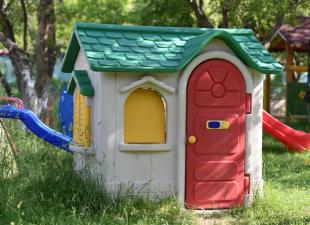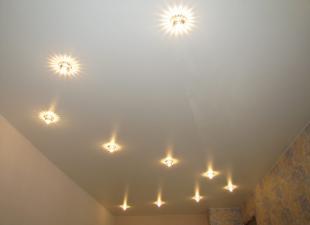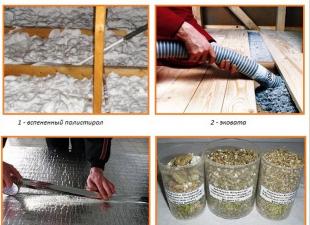They still look pretty decent, but the ceiling does not stand up to criticism. By painting only the ceiling, and without touching the walls, you can save money and postpone serious repair work for at least several years. An excellent material for any type of premises is water-based paint: it is environmentally friendly, some of its varieties are perfectly cleanable, and even an inexperienced painter can work with it.
You just need to prepare the necessary materials in advance and. So that the result of your work will satisfy you, before painting the ceiling with water-based paint, tune in to the fact that the painting process will take place in several stages and will take at least three to four days.
Preparation of tools and materials
Water-based dye is a suspension consisting of the smallest particles of polymers diluted with water. When the paint dries, the thinnest, perfectly smooth polymer film forms. Depending on the chemical composition of the polymers, water-based paints are classified as follows:
- acrylic-based dyes are the most popular. The surfaces painted with them are resistant to wiping with a damp sponge;
- acrylic-latex-based dyes withstand washing with detergents. Such dyes are quite expensive, but they can be used even in rooms with a high probability of ceiling contamination (in kitchens);
- dyes based on polyvinyl acetate are the cheapest, but cannot be washed at all and are suitable exclusively for dry rooms;
- silicone-based dyes are vapor permeable and have antifungal properties. They are used in bathrooms and other rooms with high humidity. Before painting, the plastered surface does not need preliminary priming;
- silicate-based dyes contain water glass. They are applied to concrete and brick.
The paint should be selected based on the content of the instructions. On the label of the can, manufacturers indicate for what work and premises it is intended, what should be the operating conditions and what is the consumption of the dye. Only waterproof ceiling water-based dyes are suitable for indoor use.

If you are sure that you will be able to bring the ceiling to a perfectly even look before painting, buy glossy paint: it is applied with a beautiful shiny layer. But all the flaws (bumps, cracks) of the ceiling such paint only shows. Surface imperfections are well hidden by matte paint. If the imperfections of the ceiling are not too great, you can purchase a semi-matt paint. When buying paint, pay attention to the degree of coverage - the ability to cover up dirty spots.
When calculating the required amount of paint, be guided by the data on its consumption indicated on the label, as well as on the footage of your room. Increase the resulting figure three times: the paint will be applied in two or three layers. Be sure to buy all the paint at once, and make sure that the cans are from the same batch, since in different batches the paint may differ in shade fractions, but this is enough to ruin it. In no case do not buy frozen paint: at low temperatures it is divided into fractions, which cannot be mixed.
Choice of tools
To paint the ceiling you will need:
- paint flange brushes 5–10 cm wide. You can take one slightly wider - for painting the corners, and one very narrow - for corrective work;
- two or three rollers 10–25 cm wide. It is better not to take foam rollers: they fail after painting 10 m 2, and the paint applied with their help blows up with bubbles. It is most convenient to paint the ceiling with rollers with long pile. Rollers with a short nap or felt coat are inconvenient to work: they will have to be dipped in paint too often, and there will be a lot of gaps on the ceiling. It is also important to choose the right roller handle (clasp): it should be comfortable and durable. If you do not want to use a stepladder, you should attach a long telescopic handle to the roller;
- a paint tray with a wide rim or a separate ribbed board, designed so that, by rolling a roller over it, you can distribute the paint on it as evenly as possible;
- construction and ordinary scotch tape;
- film;
- personal protective equipment: respirator, goggles, gloves.

Additional materials
For pretreating the ceiling surface, you will probably need:
- deep penetration acrylic primer;
- antiseptic primer;
- putty for cracks and joints;
- finishing putty;
- serpyanka ribbon;
- fine-grained sandpaper.
Before painting the ceiling with water-based emulsion, you must transfer the room to "martial law": everything that can be taken out, and furniture that cannot be taken out must be securely covered with a film fixed with tape. Get ready for the fact that the room will be in this state for several days. It should also be protected by covering it with two layers of foil. In order not to carry dirt around the house, sketch out old newspapers on the film, which can be changed periodically. Do not forget to paste over the areas of surfaces adjacent to the painting area with construction tape.

After that, we proceed to the preparation of the ceiling. Fine if it was chalked. Then, with a washcloth or spray bottle, moisten the whitewash abundantly and scrape it off with an iron spatula. The wallpaper-covered ceiling should be completely cleaned of both paper and glue. Worse if the ceiling has been painted with water-based paint. Then you need to moisten it abundantly, in two steps with a difference of 20 minutes, and then arrange a strong draft in the room. The paint will swell, and you can peel it off in whole layers.
If there are stains or smudges on the ceiling cleaned of whitewash or glue, they should be removed with a 5% solution of copper sulfate. Stubborn stains can be removed with a 2–3% hydrochloric acid solution. Experienced craftsmen advise the so-called "building mask": the application of a thick limestone-water solution to the stain with the addition of 50 ml of denatured alcohol. The prepared mixture should be kept in the contaminated area for ten to fifteen minutes, then removed and, if necessary, repeat the procedure again.
To prevent the formation of foci of mold, cleaned ceilings, especially in old houses, are recommended to be treated with an antiseptic primer or the usual "Whiteness". Then the ceiling is leveled, filling up all the cracks with putty and serpyanka tape. After drying, the putty places are sanded. To make the ceiling surface perfectly flat, it makes sense to cover it with a finishing whitewash-putty, which has an oil-and-glue base.
To increase the adhesion (adhesion) of the paint to the surface, the ceiling is treated with a deep penetration acrylic primer. You can do otherwise: dilute the paint with water in a 1: 2 ratio and cover the ceiling surface with it. This allows you to reveal everything, but the paint is much more expensive than the primer.
The main principle of ceiling painting is that each subsequent layer of paint can only be applied to a well-dried surface. Since the paint dries from eight to twelve hours, and it is better to paint during daylight hours, only one coat is usually applied per day.
Some people like the ceiling to be painted not in snow-white, but in a slightly bluish or greenish color. This makes sense: subsequently, dirt is less visible on the pale blue surface. In order to achieve the desired shade, they buy white paint and a color scheme, which is gradually added to it. Then a dab of paint is applied to white cardboard. You can evaluate the shade only after the smear has dried.
The paint from the can is poured into a pre-prepared bath. Before that, it is necessary to thoroughly stir the dye directly in the jar. If the instructions say that the dye must be diluted with water, the liquid should be added to the bath little by little and stir well, assessing the thickness of the solution: it will not be possible to thicken paint that is too liquid.

Begin painting by finishing the corners with a paint brush. Then comes the turn of the roller. Each time, having dipped it in the bath, you need to shake it off the edge or run it along the ribbed surface to get rid of excess dye. The ceiling should be painted with precise movements reminiscent of the letter "W". Each subsequent stroke should overlap the adjacent one by 2-3 cm. The layer of the applied dye should be as thin as possible: several thin layers applied one on top of the other look much better than one thick one. Small streaks can be removed with a roller only if the dye has not yet begun to dry. Otherwise, it is better to wait until the layer is completely dry and apply another one on top.
Usually they are limited to applying two coats of paint, but in order to hide significant flaws, you can paint a third time. The strokes in each of the layers should be perpendicular to the strokes of the previous one. If two layers are applied, then the strokes of the first should be parallel to the wall with the window, the strokes of the second should be perpendicular. This is done so that the strokes of the last layer are aligned with the rays of light entering the window. In rooms without windows facing the street, they are guided by the source of natural light. For the last layer, always save a new roller: this will make the dye smoother.
It is better to have a person at the bottom who would tell you where else you need to touch up. The fact is that you yourself will not be able to see the ceiling flaws during the staining process: they are noticeable only at an angle of 30–40º. If, after applying the next layer, irregularities and streaks of the previous one are still visible, it makes sense to sand the ceiling and paint it again.
To paint the ceiling with a spray gun, direct the dye jet strictly perpendicular to the surface from a distance of about 70 cm.

The paint is applied evenly, in a circular motion, keeping the same pace. Be sure to use a respirator and goggles!
With these simple tips, you can surely be able to choose the right paint and paint your ceiling well.
And finally, a short video on how to paint the ceiling yourself :
 parlini.ru Repair of an apartment, a summer residence and a house.
parlini.ru Repair of an apartment, a summer residence and a house.


